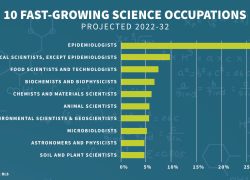For some workers, every day is Earth Day. Did you know studying how to protect the planet often leads to a good paycheck, too?
Data from the U.S. Bureau of Labor Statistics show that many scientists and engineers in green jobs had wages that were higher than the $45,760 median for all occupations in 2021. In addition, the bureau projects more than 30,000 openings overall each year, on average, from 2021 to 2031 for the 10 occupations shown below:

Atmospheric scientists study the weather and climate, including the effects of air pollution on the environment.
2021 median annual wage: $94,570
Number of jobs, 2021: 9,100
2021–31 projected openings, annual average: 700
Typical entry-level education: Bachelor’s degree
Biochemists and biophysicists study the chemical makeup of organisms. Their work may include investigating sources of renewable energy from plants or developing ways to clean up pollution.
2021 median annual wage: $102,270
Number of jobs, 2021: 37,500
2021–31 projected openings, annual average: 4,000
Typical entry-level education: Doctoral or professional degree
Chemists research and analyze substances to develop new materials, including those that may be useful for controlling pollution.
2021 median annual wage: $79,430
Number of jobs, 2021: 83,600
2021–31 projected openings, annual average: 7,600
Typical entry-level education: Bachelor’s degree
Conservation scientists manage the use and development of natural resources. Their duties may include protecting wildlife habitats, biodiversity, and ecosystems or advising landowners on issues such as water quality and erosion.
2021 median annual wage: $63,750
Number of jobs, 2021: 24,600
2021–31 projected openings, annual average: 2,300
Typical entry-level education: Bachelor’s degree
Environmental engineers research, design, plan, or perform engineering duties to prevent, control, and remediate environmental hazards. They work on problems such as waste disposal, public health, and water and air pollution.
2021 median annual wage: $96,820
Number of jobs, 2021: 44,000
2021–31 projected openings, annual average: 3,400
Typical entry-level education: Bachelor’s
Environmental scientists conduct research to identify, abate, or eliminate sources of pollutants or hazards affecting the environment and the population.
2021 median annual wage: $76,530
Number of jobs, 2021: 80,000
2021–31 projected openings, annual average: 7,800
Typical entry-level education: Bachelor’s degree
Geoscientists study the physical aspects of the Earth, such as its composition, structure, and processes, to learn about its past and present and to predict future events.
2021 median annual wage: $83,680
Number of jobs, 2021: 24,900
2021–31 projected openings, annual average: 2,400
Typical entry-level education: Bachelor’s degree
Hydrologists study how water moves across and through the Earth’s crust. They analyze data on the environmental impacts of erosion, drought, and other problems related to water.
2021 median annual wage: $84,030
Number of jobs, 2021: 6,800
2021–31 projected openings, annual average: 600
Typical entry-level education: Bachelor’s degree
Materials scientists research the structures and chemical properties of materials to develop new products, such as sustainable alternatives to existing processes for helping to reduce pollution.
2021 median annual wage: $100,090
Number of jobs, 2021: 7,000
2021–31 projected openings, annual average: 600
Typical entry-level education: Bachelor’s degree
Microbiologists study microscopic organisms, including bacteria, algae and viruses. They study how microorganisms interact with the environment and each other, such as the use of microbes to clean up contaminated areas.
2021 median annual wage: $79,260
Number of jobs, 2021: 20,800
2021–31 projected openings, annual average: 2,000
Typical entry-level education: Bachelor’s degree
Explore these and hundreds of other occupations in the Bureau of Labor Statistics’ Occupational Outlook Handbook. You’ll find career exploration and assessment tools at the U.S. Department of Labor’s O*NET Resource Center. In addition, you can find more green careers by visiting O*NET’s Green Topics page.
Patricia Tate is an economist in the U.S. Bureau of Labor Statistics. Follow BLS on Twitter at @BLS_gov.

 U.S. Department of Labor Blog
U.S. Department of Labor Blog






